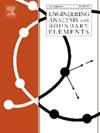三维边界元法中由距离变换衍生的各种近奇点正则化方法
IF 4.2
2区 工程技术
Q1 ENGINEERING, MULTIDISCIPLINARY
Engineering Analysis with Boundary Elements
Pub Date : 2025-02-01
DOI:10.1016/j.enganabound.2024.106094
引用次数: 0
摘要
研究了非线性变换在近奇点正则化组合距离变换中的应用。在以往的方法中,通常只考虑极坐标方向上的近奇异点,而忽略了圆方向上的近奇异点,导致在计算窄元近奇异积分或投影点位于元端附近时精度较低。本文首先基于距离函数对近奇异点进行跟踪,然后用两种方法构造距离函数。导出了两个方向上近似奇异积分的一般形式。在此基础上,引入了几种非线性变换,用于消除一个方向上的近奇异点。该方法结合了单方向法求解近奇异积分。最后,结合距离变换的结果进行了比较,结果表明,在两个方向上采用非线性变换可以得到更稳定和准确的结果,特别是对于窄单元的近奇异积分。本文章由计算机程序翻译,如有差异,请以英文原文为准。
Various near singularity regularization methods derived from distance transformations in 3D boundary element method
This paper focuses on applying non-linear transformations for near singularity regularization combined distance transformations. In the previous methods, near singularities are usually considered in only the polar direction, ignoring those in the circular direction, which leads to low accuracy when calculating nearly singular integrals of narrow element or when the projection point is located near the element end. In this paper, the near singularities are traced firstly based on the distance function, by which the distance function can be constructed in two ways. The general form of nearly singular integrals in the two directions is extracted. Then, several non-linear transformations are introduced about removal of the near singularities in one direction. In our method, the only one directional methods are combined to solve the nearly singular integrals. Finally, comparisons of the results by the combined distance transformations show that by employing the non-linear transformations in both directions, more stable and accurate results can be obtained especially for nearly singular integrals of the narrow elements.
求助全文
通过发布文献求助,成功后即可免费获取论文全文。
去求助
来源期刊

Engineering Analysis with Boundary Elements
工程技术-工程:综合
CiteScore
5.50
自引率
18.20%
发文量
368
审稿时长
56 days
期刊介绍:
This journal is specifically dedicated to the dissemination of the latest developments of new engineering analysis techniques using boundary elements and other mesh reduction methods.
Boundary element (BEM) and mesh reduction methods (MRM) are very active areas of research with the techniques being applied to solve increasingly complex problems. The journal stresses the importance of these applications as well as their computational aspects, reliability and robustness.
The main criteria for publication will be the originality of the work being reported, its potential usefulness and applications of the methods to new fields.
In addition to regular issues, the journal publishes a series of special issues dealing with specific areas of current research.
The journal has, for many years, provided a channel of communication between academics and industrial researchers working in mesh reduction methods
Fields Covered:
• Boundary Element Methods (BEM)
• Mesh Reduction Methods (MRM)
• Meshless Methods
• Integral Equations
• Applications of BEM/MRM in Engineering
• Numerical Methods related to BEM/MRM
• Computational Techniques
• Combination of Different Methods
• Advanced Formulations.
 求助内容:
求助内容: 应助结果提醒方式:
应助结果提醒方式:


